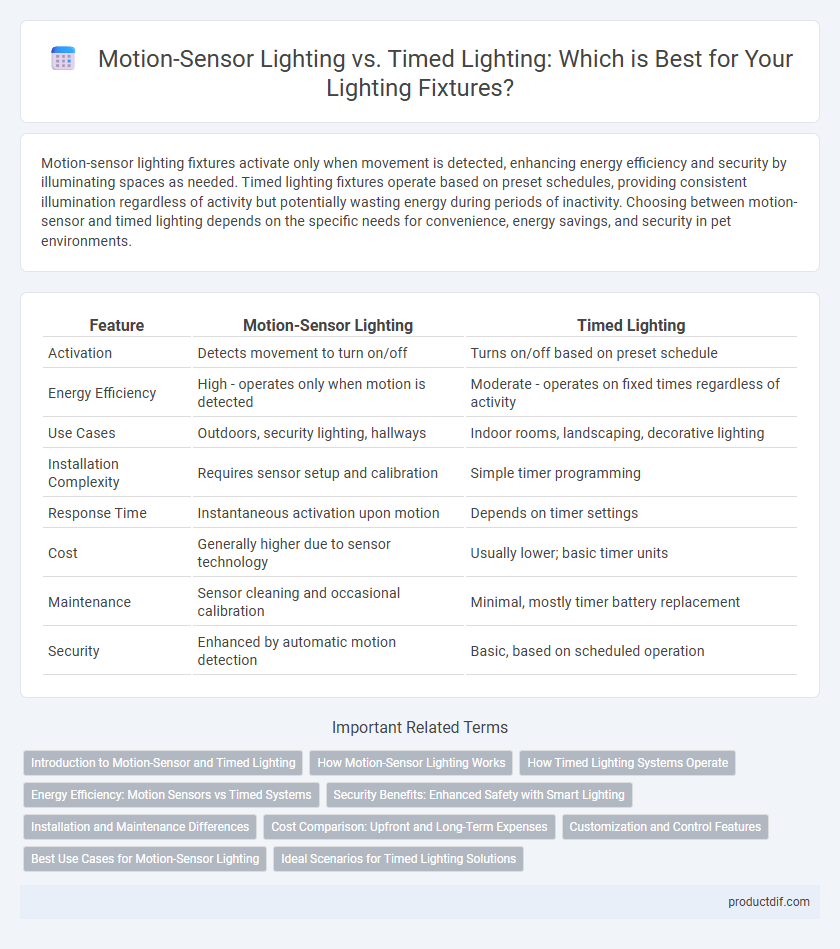Motion-sensor lighting fixtures activate only when movement is detected, enhancing energy efficiency and security by illuminating spaces as needed. Timed lighting fixtures operate based on preset schedules, providing consistent illumination regardless of activity but potentially wasting energy during periods of inactivity. Choosing between motion-sensor and timed lighting depends on the specific needs for convenience, energy savings, and security in pet environments.
Table of Comparison
| Feature | Motion-Sensor Lighting | Timed Lighting |
|---|---|---|
| Activation | Detects movement to turn on/off | Turns on/off based on preset schedule |
| Energy Efficiency | High - operates only when motion is detected | Moderate - operates on fixed times regardless of activity |
| Use Cases | Outdoors, security lighting, hallways | Indoor rooms, landscaping, decorative lighting |
| Installation Complexity | Requires sensor setup and calibration | Simple timer programming |
| Response Time | Instantaneous activation upon motion | Depends on timer settings |
| Cost | Generally higher due to sensor technology | Usually lower; basic timer units |
| Maintenance | Sensor cleaning and occasional calibration | Minimal, mostly timer battery replacement |
| Security | Enhanced by automatic motion detection | Basic, based on scheduled operation |
Introduction to Motion-Sensor and Timed Lighting
Motion-sensor lighting activates illumination based on detected movement, enhancing energy efficiency and security by only turning lights on when needed. Timed lighting operates according to preset schedules, allowing consistent control over lighting duration regardless of occupancy. Both systems offer distinct advantages for optimizing energy use and convenience in residential and commercial environments.
How Motion-Sensor Lighting Works
Motion-sensor lighting operates by detecting infrared radiation or movement within a designated range, triggering the light to turn on automatically when motion is sensed. These fixtures use passive infrared (PIR) sensors or microwave sensors to monitor changes in heat or velocity, ensuring energy efficiency by illuminating only when needed. Unlike timed lighting, motion sensors provide adaptive illumination based on real-time activity, enhancing security and convenience in both residential and commercial spaces.
How Timed Lighting Systems Operate
Timed lighting systems operate by programming lights to turn on and off at specific intervals using built-in clocks or digital timers, enabling consistent energy savings and automated control. These systems rely on preset schedules rather than real-time activity detection, making them ideal for environments with predictable usage patterns. Integration with smart home technology further enhances timed lighting by allowing remote adjustments and synchronization with other devices for optimized energy efficiency.
Energy Efficiency: Motion Sensors vs Timed Systems
Motion-sensor lighting enhances energy efficiency by activating fixtures only when movement is detected, significantly reducing unnecessary power consumption compared to timed lighting systems that remain on for preset intervals regardless of occupancy. Timed lighting can lead to energy waste during periods of inactivity if the preset duration exceeds actual use. Studies show that motion sensors can cut lighting energy use by up to 50%, making them superior for optimizing energy savings in residential and commercial spaces.
Security Benefits: Enhanced Safety with Smart Lighting
Motion-sensor lighting significantly improves security by automatically illuminating areas when movement is detected, deterring potential intruders and reducing blind spots around properties. Timed lighting offers consistent illumination by turning lights on and off at preset intervals, maintaining the appearance of occupancy to discourage unauthorized access. Smart lighting systems integrating motion sensors and timed functions provide comprehensive safety by adapting to real-time activity while preserving energy efficiency.
Installation and Maintenance Differences
Motion-sensor lighting requires precise placement of sensors to ensure accurate detection of movement, which can complicate installation compared to timed lighting that relies on simple timers or programmable switches. Maintenance for motion-sensor fixtures involves periodic sensor calibration and potential sensitivity adjustments, whereas timed lighting systems primarily need battery or power source checks. Both systems demand routine inspections, but motion-sensor lighting often entails more technical upkeep due to sensor functionality.
Cost Comparison: Upfront and Long-Term Expenses
Motion-sensor lighting typically has a higher upfront cost due to sensor installation and advanced technology, but it reduces long-term energy expenses by activating lights only when needed. Timed lighting systems are generally less expensive to install but may increase electricity bills by remaining on during preset intervals regardless of actual room usage. Over time, motion-sensor lighting tends to offer greater cost efficiency through energy savings and reduced maintenance compared to timed lighting fixtures.
Customization and Control Features
Motion-sensor lighting offers advanced customization with adjustable sensitivity settings, programmable activation zones, and real-time responsiveness to movement, enabling efficient energy use and enhanced security. Timed lighting relies on preset schedules, providing control through fixed on/off intervals but lacking adaptability to actual occupancy or environmental changes. Integrating smart technology into both systems enhances control features, allowing remote access and personalized configurations via mobile apps or centralized home automation platforms.
Best Use Cases for Motion-Sensor Lighting
Motion-sensor lighting is ideal for security purposes in outdoor areas such as driveways, walkways, and entrances where automatic illumination deters intruders and conserves energy. It excels in spaces with inconsistent occupancy like garages, closets, and bathrooms, providing light only when needed to enhance convenience and reduce electricity costs. Motion-sensor lighting also benefits commercial settings like warehouses and stairwells by improving safety and operational efficiency through responsive illumination.
Ideal Scenarios for Timed Lighting Solutions
Timed lighting solutions are ideal for outdoor security lighting, where lights automatically activate at dusk and turn off at dawn to conserve energy while maintaining consistent illumination. These systems are particularly effective in areas with predictable activity patterns, such as parking lots, walkways, and building exteriors, ensuring safety without requiring motion detection. Timed lighting also suits commercial and residential settings where maintaining a steady light schedule reduces manual intervention and enhances convenience.
Motion-sensor lighting vs Timed lighting Infographic

 productdif.com
productdif.com